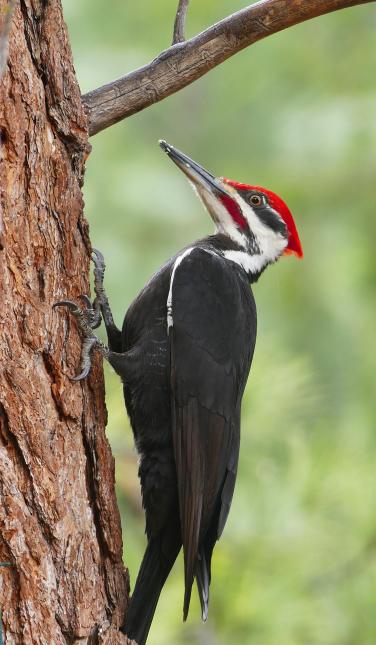Woodpeckers in Florida: Identification Tips and Habitat Preferences
Woodpeckers Unleashed: Checking Out the Wonders of These Knowledgeable Tree Mountain Climbers
Woodpeckers, with their distinctive markings and balanced drumming echoing with wooded locations, hold a distinct location in the bird world - Woodpeckers in Florida. As we dig right into the complex information of woodpeckers' nesting practices, feeding strategies, and the continuous preservation efforts to safeguard these impressive birds, a deeper admiration for their location in nature unfolds.
Composition and Adaptations
When analyzing the anatomy and adaptations of woodpeckers, one can observe remarkable attributes that make it possible for these birds to grow in their specialized environmental niche. Furthermore, woodpeckers have zygodactyl feet, with 2 toes encountering forward and two encountering backwards, supplying a firm grip on tree trunks while they browse for food or drum for communication.
Additionally, woodpeckers have a distinct tongue structure that is long, barbed, and sticky, allowing them to draw out insects from holes in timber. This specific adjustment enables woodpeckers to make use of a food resource that is hard to reach to numerous other bird varieties. In general, the anatomy and adjustments of woodpeckers showcase the impressive evolutionary solutions that have actually allowed these birds to grow in their arboreal habitat.
Drumming Behavior
Having actually explored the composition and adaptations of woodpeckers, the emphasis now changes to understanding their drumming actions, a distinctive facet of their communication and territorial display screens. Drumming is an important kind of communication amongst woodpeckers, serving several purposes such as establishing regions, drawing in friends, and signaling alarm. Each woodpecker types has an unique drumming pattern that assists people acknowledge participants of their own types and identify them from competitors or predators.
Woodpeckers generate drumming sounds by quickly pecking on powerful surface areas such as dead trees, utility poles, or perhaps steel objects, producing a collection of rhythmic beats. The intensity and rate of drumming can differ based on the objective; as an example, a rapid drumming sequence might indicate aggression towards burglars, while a slower and softer drumming pattern might show courtship (Woodpeckers in Florida). Additionally, woodpeckers may change the regularity and duration of their drumming to communicate particular messages successfully
Nesting Routines
Checking out the nesting habits of woodpeckers reveals interesting insights into their reproductive actions and habitat options. Woodpeckers are known for their special nesting preferences, frequently excavating dental caries in trees to develop sheltered rooms for elevating their young. These tooth cavities serve not only as a nesting website however likewise as a protected haven from predators and severe weather condition.
Woodpeckers show a high degree of fidelity to their nesting sites, frequently returning to the same location time after time. This habits highlights the value of suitable habitat schedule for their reproductive success. The selection of a nesting site is crucial for woodpeckers, with elements such as tree types, elevation, and degeneration phase playing considerable functions in their decision-making process.
Surprisingly, some woodpecker types are known to dig deep into several read what he said cavities within their area, providing themselves with alternate nesting alternatives. This technique might work as a kind of insurance against prospective threats or disturbances to their primary nesting site.

Feeding Methods
Woodpeckers go to this website employ a range of specialized feeding techniques to procure their primary food resources. Among the most unique feeding actions of woodpeckers is drumming, which includes quick pecking on trees to uncover bugs below the bark. This drumming not just aids them locate prey however additionally serves as a means of communication with other woodpeckers. Woodpeckers have solid, chisel-like beaks that enable them to pierce right into timber easily. As soon as an opening is created, they use their long, barbed tongues to extract bugs such as ants, beetles, larvae, and spiders. These tongues are coated with sticky saliva that assists trap the prey. Woodpeckers are also known to excavate tooth cavities in trees to gain access to concealed insect larvae or sap. Some varieties, like the acorn woodpecker, shop nuts in particularly created openings called granaries. This critical storing of food helps them survive during food scarcity periods. Woodpeckers are truly remarkable in their feeding techniques, showcasing adaptability and knowledge in acquiring their nourishment.
Preservation Initiatives
In the middle of the elaborate feeding techniques showed by woodpeckers, the conservation efforts targeted at securing these interesting birds play a critical function in preserving their environments and populations. Woodpeckers face numerous dangers to their survival, including environment loss useful site because of logging, environment change modifying their ecological communities, and accidents with man-made frameworks such as buildings and lorries - Woodpeckers in Florida. Preservationists are actively functioning to deal with these obstacles and make sure the long-term wellness of woodpecker species

Education and public awareness projects are likewise vital elements of woodpecker preservation initiatives. By raising recognition concerning the value of these birds in preserving healthy and balanced woodland communities, conservationists can amass support for environment conservation campaigns and promote liable land administration practices. With collaborative initiatives between scientists, policymakers, and local neighborhoods, we can collaborate to secure a future where woodpeckers prosper in their natural environments.
Conclusion
